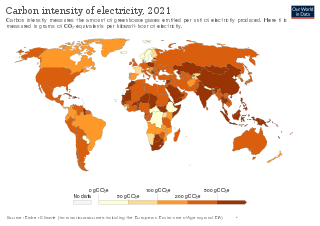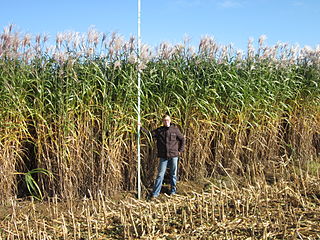Energy and CO2 output of common biofuels
The table below includes entries for popular substances already used for their energy, or being discussed for such use.
The second column shows specific energy, the energy content in megajoules per unit of mass in kilograms, useful in understanding the energy that can be extracted from the fuel.
The third column in the table lists energy density, the energy content per liter of volume, which is useful for understanding the space needed for storing the fuel.
The final two columns deal with the carbon footprint of the fuel. The fourth column contains the proportion of CO2 released when the fuel is converted for energy, with respect to its starting mass, and the fifth column lists the energy produced per kilogram of CO2 produced. As a guideline, a higher number in this column is better for the environment. But these numbers do not account for other green house gases released during burning, production, storage, or shipping. For example, methane may have hidden environmental costs that are not reflected in the table.
| Fuel Type | Specific energy (MJ/kg) | Energy Density (MJ/L) | CO2 Gas made from Fuel Used (kg/kg) [nb 1] | Energy per CO2 (MJ/kg) |
|---|---|---|---|---|
| Solid Fuels | ||||
| Bagasse (Cane Stalks) | 9.6 | ~+40%(C6H10O5)n+15% (C26H42O21)n+15% (C9H10O2)n1.30 | 7.41 | |
| Chaff (Seed Casings) | 14.6 | [Please insert average composition here] | ||
| Animal Dung/Manure | 10- 15 | [Please insert average composition here] | ||
| Dried plants (C6H10O5)n | 10 – 16 | 1.6 - 16.64 | IF 50%(C6H10O5)n+25% (C26H42O21)n+25% (C10H12O3)n1.84 | 5.44-8.70 |
| Wood fuel (C6H10O5)n | 16 – 21 | 2.56 - 21.84 | IF 45%(C6H10O5)n+25% (C26H42O21)n+30% (C10H12O3)n1.88 | 8.51-11.17 |
| Charcoal | 30 | 5.4-6.6 | 85-98% Carbon+VOC+Ash 3.63 | 8.27 |
| Liquid Fuels | ||||
| Pyrolysis oil | 17.5 | 21.35 | varies | varies |
| Methanol (CH3-OH) | 19.9 – 22.7 | 15.9 | 1.37 | 14.49-16.53 |
| Ethanol (CH3-CH2-OH) | 23.4 – 26.8 | 18.4 - 21.2 | 1.91 | 12.25-14.03 |
| Ecalene | 28.4 | 22.7 | 75%C2H6O+9%C3H8O+7%C4H10O+5%C5H12O+4%Hx 2.03 | 14.02 |
| Butanol(CH3-(CH2)3-OH) | 36 | 29.2 | 2.37 | 15.16 |
| Fat | 37.656 | 31.68 | C55H104O6 | |
| Biodiesel | 37.8 | 33.3 – 35.7 | ~2.85 | ~13.26 |
| Sunflower oil (C18H32O2) | 39.49 | 33.18 | (12% (C16H32O2)+16% (C18H34O2)+71% (LA)+1% (ALA))2.81 | 14.04 |
| Castor oil (C18H34O3) | 39.5 | 33.21 | (1% PA+1% SA+89.5% ROA+3% OA+4.2% LA+0.3% ALA)2.67 | 14.80 |
| Olive oil (C18H34O2) | 39.25 - 39.82 | 33 - 33.48 | (15% (C16H32O2)+75% (C18H34O2)+9% (LA)+1% (ALA))2.80 | 14.03 |
| Gaseous Fuels | ||||
| Methane (CH4) | 55 – 55.7 | (Liquefied) 23.0 – 23.3 | (Methane leak exerts 23 × greenhouse effect of CO2) 2.74 | 20.05-20.30 |
| Hydrogen (H2) | 120 – 142 | (Liquefied) 8.5 – 10.1 | (Hydrogen leak slightly catalyzes ozone depletion) 0.0 | |
| Fossil Fuels (comparison) | ||||
| Coal | 29.3 – 33.5 | 39.85 - 74.43 | (Not Counting:CO, NOx, Sulfates & Particulates) ~3.59 | ~8.16-9.33 |
| Crude Oil | 41.868 | 28 – 31.4 | (Not Counting:CO,NOx,Sulfates & Particulates) ~3.4 | ~12.31 |
| Gasoline | 45 – 48.3 | 32 – 34.8 | (Not Counting:CO,NOx,Sulfates & Particulates) ~3.30 | ~13.64-14.64 |
| Diesel | 48.1 | 40.3 | (Not Counting:CO,NOx,Sulfates & Particulates) ~3.4 | ~14.15 |
| Natural Gas | 38 – 50 | (Liquefied) 25.5 – 28.7 | (Ethane, Propane & Butane N/C:CO,NOx & Sulfates) ~3.00 | ~12.67-16.67 |
| Ethane (CH3-CH3) | 51.9 | (Liquefied) ~24.0 | 2.93 | 17.71 |
| Nuclear fuels (comparison) [nb 2] | ||||
| Uranium -235 (235U) | 77,000,000 | (Pure)1,470,700,000 | [Greater for lower ore conc.(Mining, Refining, Moving)] 0.0 | ~55 [4] - ~90 [3] |
| Nuclear fusion (2H -3H) | 300,000,000 | (Liquefied)53,414,377.6 | (Sea-Bed Hydrogen-Isotope Mining-Method Dependent) 0.0 | |
| Fuel Cell Energy Storage (comparison) | ||||
| Direct-Methanol | 4.5466 | 3.6 | ~1.37 | ~3.31 |
| Proton-Exchange (R&D) | up to 5.68 | up to 4.5 | (IFF Fuel is recycled) 0.0 | |
| Sodium Hydride (R&D) | up to 11.13 | up to 10.24 | (Bladder for Sodium Oxide Recycling) 0.0 | |
| Battery Energy Storage (comparison) | ||||
| Lead-acid battery | 0.108 | ~0.1 | (200-600 Deep-Cycle Tolerance) 0.0 | |
| Nickel-iron battery | 0.0487 - 0.1127 | 0.0658 - 0.1772 | (<40y Life)(2k-3k Cycle Tolerance IF no Memory effect) 0.0 | |
| Nickel-cadmium battery | 0.162 - 0.288 | ~0.24 | (1k-1.5k Cycle Tolerance IF no Memory effect) 0.0 | |
| Nickel metal hydride | 0.22 - 0.324 | 0.36 | (300-500 Cycle Tolerance IF no Memory effect) 0.0 | |
| Super iron battery | 0.33 | (1.5 * NiMH) 0.54 | (~300 Deep-Cycle Tolerance) 0.0 | |
| Zinc-air battery | 0.396 - 0.72 | 0.5924 - 0.8442 | (Recyclable by Smelting & Remixing, not Recharging) 0.0 | |
| Lithium ion battery | 0.54 - 0.72 | 0.9 - 1.9 | (3-5 y Life) (500-1k Deep-Cycle Tolerance) 0.0 | |
| Lithium-Ion-Polymer | 0.65 - 0.87 | (1.2 * Li-Ion)1.08 - 2.28 | (3-5 y Life) (300-500 Deep-Cycle Tolerance) 0.0 | |
| Lithium iron phosphate battery | ||||
| DURACELL Zinc-Air | 1.0584 - 1.5912 | 5.148 - 6.3216 | (1-3 y Shelf-life) (Recyclable not Rechargeable) 0.0 | |
| Aluminium battery | 1.8 - 4.788 | 7.56 | (10-30 y Life) (3k+ Deep-Cycle Tolerance) 0.0 | |
| PolyPlusBC Li-Aircell | 3.6 - 32.4 | 3.6 - 17.64 | (May be Rechargeable)(Might leak sulfates) 0.0 | |
Notes
- ↑ While all CO2 gas output ratios are calculated to within a less than 1% margin of error(assuming total oxidation of the carbon content of fuel), ratios preceded by a Tilde (~) indicate a margin of error of up to (but no greater than) 9%. Ratios listed do not include emissions from fuel plant cultivation/Mining, purification/refining and transportation. Fuel availability is typically 74–-84.3% NET from source Energy Balance.
- ↑ While Uranium-235 (235U) fission produces no CO2 gas directly, the indirect fossil fuel burning processes of Mining, Milling, Refining, Moving & Radioactive waste disposal, etc. of intermediate to low-grade uranium ore concentrations produces some amount of carbon dioxide. Studies vary as to how much carbon dioxide is emitted. The United Nations Intergovernmental Panel on Climate Change reports that nuclear produces approximately 40 g of CO2 per kilowatt hour (11 g/MJ, equivalent to 90 MJ/kg CO2e). [3] A meta-analysis of a number of studies of nuclear CO2 lifecycle emissions by academic Benjamin K. Sovacool finds nuclear on average produces 66 g of CO2 per kilowatt hour (18.3 g/MJ, equivalent to 55 MJ/kg CO2e). [4] One Australian professor claims that nuclear power produces the equivalent CO2 gas emissions per MJ of net-output-energy of a Natural Gas fired power station. Prof. Mark Diesendorf, Inst. of Environmental Studies, UNSW.













